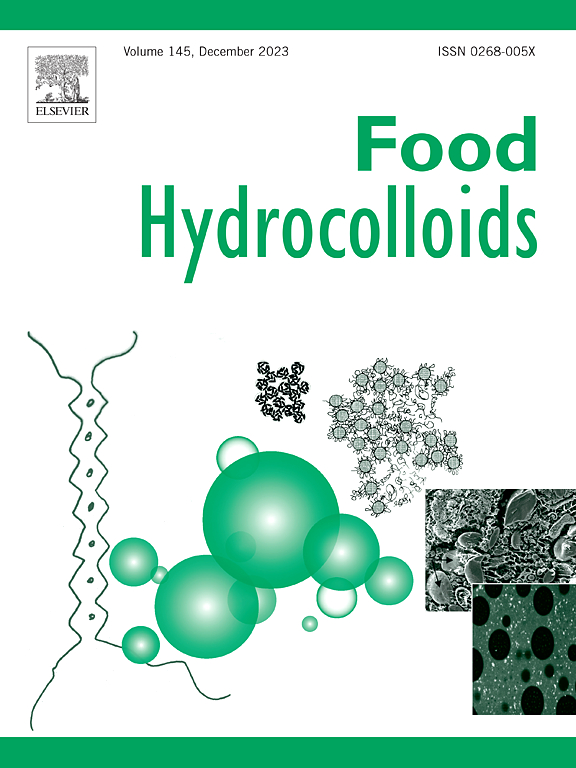Investigation into the effects of laccase and ferulic acid on the rheological and baking properties of arabinoxylan-rich doughs
IF 11
1区 农林科学
Q1 CHEMISTRY, APPLIED
引用次数: 0
Abstract
Water-soluble arabinoxylan (WSAX), a key non-starch polysaccharide in cereal grains, influences various processing properties of dough, such as rheological behavior, thermal stability, and baking performance. However, a complete understanding of the mechanism remains unclear. This study systematically examined the effects of pre-hydrated synergistic laccase (LAC)-catalyzed WSAX and ferulic acid (FA) on dough processing and baking quality, compared to direct-mix prepared doughs. The results showed that the pre-hydration treatment significantly increased G′, G″ and Jmax and enhanced the viscoelasticity, plasticity and thermal stability of the dough. LAC and exogenous FA significantly enhanced the dough ductility and decreased T21 (2.32–1.30 ms), T22 (12.67–8.36 ms) and T23 (109.77–67.55 ms) after pre-hydration. LAC pre-hydrated significantly increased the TG′max, TG″max, TG∗max, To, Tp, and Tc of the dough. Pre-hydration co-laccase-catalyzed WSAX and FA significantly affected the rheological and thermal properties of the dough. TGA results showed a decrease in dough weight loss (76.55–70.01 %) and an increase in the thermal stability of the dough. Finally, LAC significantly improved the increase in baking characteristics such as springiness and chewiness of bread due to FA addition. This study provides data support for research on the processing characteristics of LAC and FA on WSAX-enriched doughs.

漆酶和阿魏酸对富阿拉伯木聚糖面团流变学和烘烤性能影响的研究
水溶性阿拉伯木聚糖(WSAX)是谷物中重要的非淀粉多糖,影响面团的流变、热稳定性和烘烤性能等多种加工性能。然而,对其机制的完全理解仍不清楚。本研究系统地考察了预水合协同漆酶(LAC)催化的WSAX和阿魏酸(FA)对面团加工和烘焙质量的影响,并与直接混合制备的面团进行了比较。结果表明:预水化处理显著提高了面团的G′、G″和Jmax,增强了面团的粘弹性、塑性和热稳定性;LAC和外源FA显著提高了面团的延展性,降低了预水化后的T21 (2.32 ~ 1.30 ms)、T22 (12.67 ~ 8.36 ms)和T23 (109.77 ~ 67.55 ms)。预水化LAC显著提高了面团的TG 'max、TG″max、TG * max、To、Tp和Tc。预水化共漆酶催化的WSAX和FA显著影响了面团的流变学和热性能。热重分析结果表明,该方法可降低面团失重(76.55 ~ 70.01%),提高面团的热稳定性。最后,LAC显著改善了由于添加FA而增加的面包的弹性和嚼劲等烘焙特性。本研究为研究LAC和FA对富wsax面团的加工特性提供了数据支持。
本文章由计算机程序翻译,如有差异,请以英文原文为准。
求助全文
约1分钟内获得全文
求助全文
来源期刊

Food Hydrocolloids
工程技术-食品科技
CiteScore
19.90
自引率
14.00%
发文量
871
审稿时长
37 days
期刊介绍:
Food Hydrocolloids publishes original and innovative research focused on the characterization, functional properties, and applications of hydrocolloid materials used in food products. These hydrocolloids, defined as polysaccharides and proteins of commercial importance, are added to control aspects such as texture, stability, rheology, and sensory properties. The research's primary emphasis should be on the hydrocolloids themselves, with thorough descriptions of their source, nature, and physicochemical characteristics. Manuscripts are expected to clearly outline specific aims and objectives, include a fundamental discussion of research findings at the molecular level, and address the significance of the results. Studies on hydrocolloids in complex formulations should concentrate on their overall properties and mechanisms of action, while simple formulation development studies may not be considered for publication.
The main areas of interest are:
-Chemical and physicochemical characterisation
Thermal properties including glass transitions and conformational changes-
Rheological properties including viscosity, viscoelastic properties and gelation behaviour-
The influence on organoleptic properties-
Interfacial properties including stabilisation of dispersions, emulsions and foams-
Film forming properties with application to edible films and active packaging-
Encapsulation and controlled release of active compounds-
The influence on health including their role as dietary fibre-
Manipulation of hydrocolloid structure and functionality through chemical, biochemical and physical processes-
New hydrocolloids and hydrocolloid sources of commercial potential.
The Journal also publishes Review articles that provide an overview of the latest developments in topics of specific interest to researchers in this field of activity.
 求助内容:
求助内容: 应助结果提醒方式:
应助结果提醒方式:


